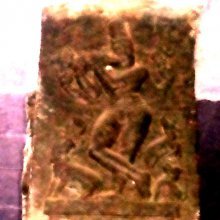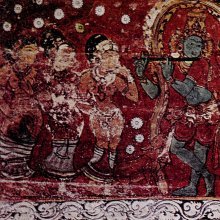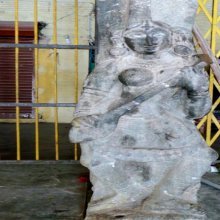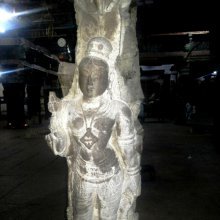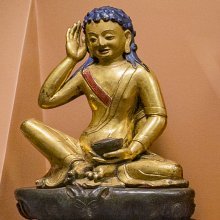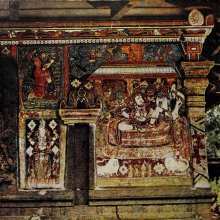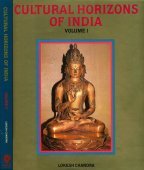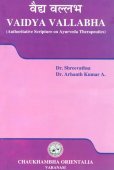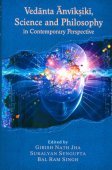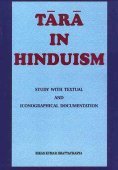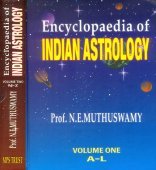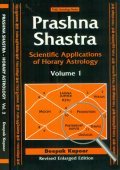Music: 3 definitions
Introduction:
Music means something in Buddhism, Pali, Hinduism, Sanskrit, the history of ancient India. If you want to know the exact meaning, history, etymology or English translation of this term then check out the descriptions on this page. Add your comment or reference to a book if you want to contribute to this summary article.
Images (photo gallery)
(+5 more images available)
In Hinduism
Purana and Itihasa (epic history)
Source: Shodhganga: Elements of Art and Architecture in the Trtiyakhanda of the VisnudharmottarapuranaMusic refers to one of the topics dealt with in the Puranic literature: a category of ancient Sanskrit texts which gives a huge contribution in the development of Indian literature.—The Vishnudharmottara Purana contains different aspects of knowledge. Along with the narratives, this work bears immense information in various fields of study. [...] The third khanda contains 118 chapters which are dedicated to various contents such as Sanskrit and Prakrit Grammar, Lexicology, Metrics, Poetics, Dance, Drama, Music, Painting, Iconography, Architecture etc.

The Purana (पुराण, purāṇas) refers to Sanskrit literature preserving ancient India’s vast cultural history, including historical legends, religious ceremonies, various arts and sciences. The eighteen mahapuranas total over 400,000 shlokas (metrical couplets) and date to at least several centuries BCE.
In Buddhism
Mahayana (major branch of Buddhism)
Source: Brill: Śaivism and the Tantric Traditions (mahayana)Music is used as a material in the performance of a sacred bathing ritual dedicated to Goddess Sarasvatī, according to the seventh chapter of the Suvarṇaprabhāsottamasūtra.—In chapter 7, the Sarasvatīparivarta, the goddess Sarasvatī grants her support to the Dharma preacher through the gift of eloquence, and presents a bathing ritual with enchanted herbs for him and his audience in order to appease all disturbances. It is promised that, invoked by praise, Sarasvatī herself will appear and remove all diseases and difficulties. The ritual instructions prescribe that one should pound herbs and consecrate the powder with mantras at the time of the Puṣya constellation. A maṇḍala should be drawn with cow-dung, flowers should be scattered and gold and silver vessels filled. Four armed men and four well-adorned maidens should be placed there holding pots in their hands, thus accomplishing the protective sealing of the boundaries (sīmābandha). One should use incense, music, umbrellas, flags, banners, mirrors, arrows, spears and dhāraṇī-spells, and in due course bathe behind an image of the Buddha.

Mahayana (महायान, mahāyāna) is a major branch of Buddhism focusing on the path of a Bodhisattva (spiritual aspirants/ enlightened beings). Extant literature is vast and primarely composed in the Sanskrit language. There are many sūtras of which some of the earliest are the various Prajñāpāramitā sūtras.
India history and geography
Source: Singhi Jain Series: Ratnaprabha-suri’s Kuvalayamala-katha (history)Music was part of the festivities such as the Kaumudi-Mahotsava festival celebrated on the Śaratpaurṇimā in ancient India, as vividly depicted in the Kathās (narrative poems) such as Uddyotanasūri in his 8th-century Kuvalayamālā (a Prakrit Campū, similar to Kāvya poetry).—Page 103.15: Here is a reference of the Kaumudī-Mahotsava celebrated in a the city of Campā on the Śaratpaurṇimā day (line 32). It was attended by great festivities of music, dance and drama. In the city-square a Naṭa gave demonstration of his dance. The Naṭa is called Bharata-putra, i.e., the follower of Bharata or an adept in Nāṭya-śāstra.

The history of India traces the identification of countries, villages, towns and other regions of India, as well as mythology, zoology, royal dynasties, rulers, tribes, local festivities and traditions and regional languages. Ancient India enjoyed religious freedom and encourages the path of Dharma, a concept common to Buddhism, Hinduism, and Jainism.
See also (Relevant definitions)
Starts with: Musical instrument, Musician.
Ends with: Buddhist Music, Indian classical music, Indian music, Instrumental music, Vocal music.
Full-text (+4111): Gandharva, Sangita, Grama, Laya, Gandhara, Tauryatrika, Vadya, Gandharvaveda, Raga, Gandharvavidya, Murchana, Vina, Svara, Abheri, Ekatala, Shadava, Dipaka, Gitavadana, Tala, Vilambita.
Relevant text
Search found 291 books and stories containing Music; (plurals include: Musics). You can also click to the full overview containing English textual excerpts. Below are direct links for the most relevant articles:
The Emerald Kingdom or The Land of the Gandharvas < [January 1971]
Triple Stream < [April – June, 2002]
‘Padmabhushan’ Dr. Sripada Pinakapani: A < [April – June, 2008]
Natyashastra (English) (by Bharata-muni)
Chapter V - Preliminaries of a Play (pūrvaraṅga)
Part 1 - The Present Work < [Introduction, Part 2]
Part 2 - The Ancient Indian Theory and Practice of Music < [Introduction, Part 2]
Vishnudharmottara Purana (Art and Architecture) (by Bhagyashree Sarma)
1. A Note on Music < [Chapter 2 - Music]
2. Origin and Development of Indian Music < [Chapter 2 - Music]
3. The Viṣṇudharmottarapurāṇa and Modern Music < [Chapter 6 - Modern Relevance of Different Art Forms and Architecture]
Shishupala-vadha (Study) (by Shila Chakraborty)
Knowledge of Music in the Śiśupālavadha < [Introduction]
Dūta in the Śiśupālavadha < [Chapter 2a - Activities of ambassador (Dūta)]
Citrakāvya (4): Bandhas < [Introduction]
Significance of the Moon in Ancient Civilizations (by Radhakrishnan. P)
1. Music Therapy at Moon Light < [Chapter 9 - Contributions of Modern Astrology]
2. Moon Light Symphony and Cardiac Patients < [Chapter 9 - Contributions of Modern Astrology]
2. Dr. Balamuralikrishna (Carnatic Voclist) < [Chapter 14 - Case Studies of Natal Chart]
Vinaya Pitaka (2): Bhikkhuni-vibhanga (the analysis of Nun’ rules) (by I. B. Horner)
Related products
(+3 more products available)
